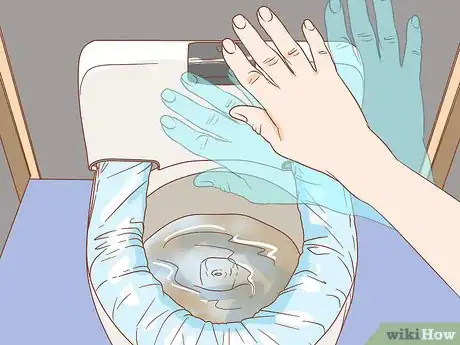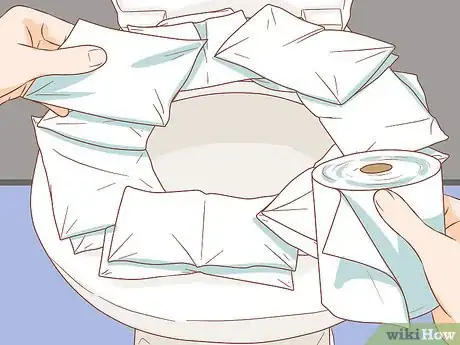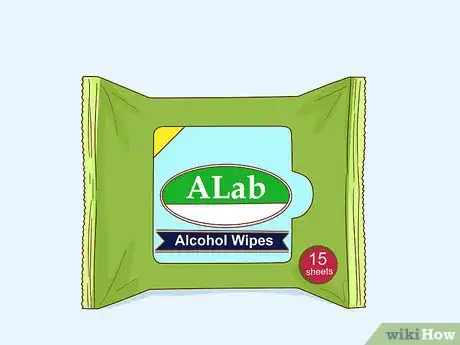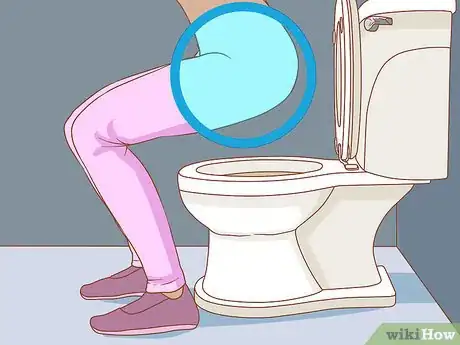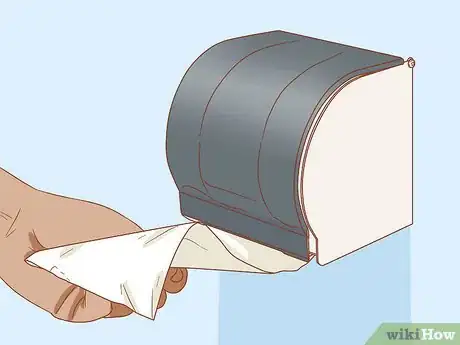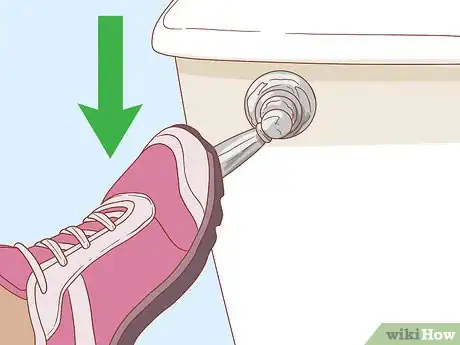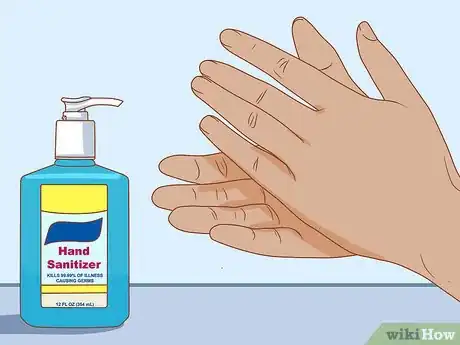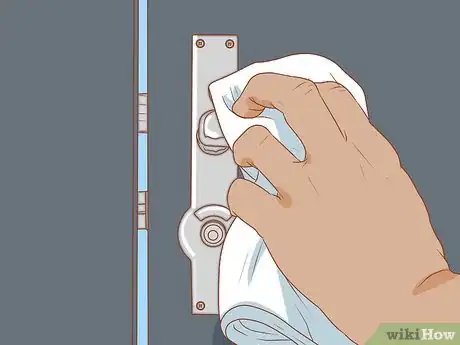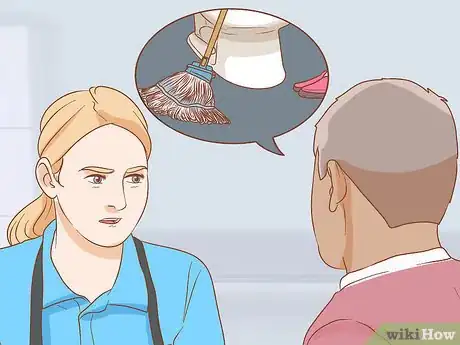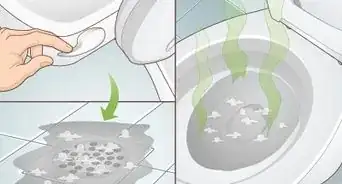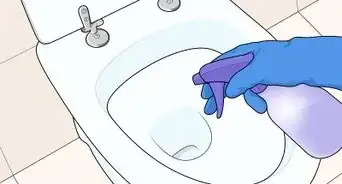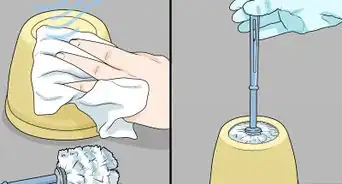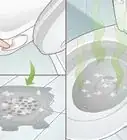This article was medically reviewed by Jennifer Boidy, RN. Jennifer Boidy is a Registered Nurse in Maryland. She received her Associate of Science in Nursing from Carroll Community College in 2012.
This article has been viewed 216,028 times.
Public restrooms often harbor different kinds of bacteria and germs that can make you sick. Although it’s unlikely that you will contract any serious diseases from a toilet seat, you may nevertheless want or need to sanitize public toilets before using them.[1] By using covers or wiping the toilet seat and making sure to wash your hands, you can disinfect a public toilet and keep yourself from picking up any bacteria that may linger on surfaces.
Steps
Using Toilet Seat Covers
-
1Use a toilet seat cover. Public restrooms may have toilet seat covers made of lightweight wax paper that you can place on the seat. Use these covers to create a barrier between your skin and the toilet seat, which may help you from coming in contact with bacteria.[2]
- These covers are usually on the wall of the restroom or in holders in each bathroom stall.
- If there is any material on the seat, or it is wet, wipe it off with some toilet paper before you place the cover on the toilet.
- Place the cover with the center tab hanging down into the water so that it flushes away after use.
- Consider carrying a personal single-use toilet seat cover for situations when no cover is available.
-
2Use automatic plastic seat covers. Some public restrooms now have automatic plastic seat covers that seal the toilet each time it is flushed. These will automatically create a barrier between your skin and the seat and don’t require you to touch the toilet in any way.
- Consider resealing the toilet twice if you notice any material in the toilet. Some studies show that water from the flushing toilet may spray the plastic cover, making it less hygienic.
Advertisement -
3Make a toilet seat cover with toilet paper. Some public restrooms don’t offer toilet seat covers. If this is the case, you can easily make one out of toilet paper. This will create a barrier between your skin and the seat and may help protect you from any bacteria lingering on surfaces.[3]
- Place a single or double layer of toilet paper around the toilet seat.[4]
- Flush the paper cover so that it isn’t on the seat for the next user.
Disinfecting the Toilet Seat
-
1Wipe the seat clean with toilet paper. Use some toilet paper to wipe the toilet seat until it is clean and dry. This will create a dry surface for you and may help remove some bacteria and germs on the toilet seat.
- You can use plain toilet paper, or you could wet the paper with some water and a little soap.
- If you carry hand sanitizer, you can also use toilet paper to wipe a few squirts of hand sanitizer over the toilet seat before use.
-
2Carry disinfecting wipes with you. Use flushable disinfectant wipes wipe surfaces in a public restroom from the seat to the toilet and door handle. These wipes may help prevent you from coming into contact with bacteria and germs.
- Many companies offer travel size packages of disinfecting wipes that you can easily carry in personal bags.
- Make sure the disinfecting wipe is safe for contact with skin. Wipe the seat with some toilet paper after disinfecting to dry it.
- To prevent clogging the toilet, check the label on sanitary wipe packages before flushing.
- Use more than one wipe if necessary.
-
3Carry small alcohol wipes. Carry alcohol wipes, which are effective at killing bacteria and germs, if you like. They are inconspicuous and may be gentler on skin than a disinfecting wipe.
- Wipe the seat thoroughly and dispose of the alcohol wipe in the trash. Allow the seat to dry before use.
- You can get alcohol wipes at most drug stores or grocery stores.
-
4Carry a travel-sized disinfectant spray bottle. Many cleaning product lines offer disinfectant sprays that can be transferred to a travel-size spray bottle for easy use in public restrooms. These sprays may help prevent you from coming into contact with bacteria and germs.
- Apply the spray liberally and allow it to sit on the seat for as long as the directions recommend.
- Wipe the seat with clean toilet paper after spraying sanitizer solution.
Sanitizing with Other Methods
-
1Squat over the toilet seat. If a public restroom is unsanitary and there are no covers or disinfectants available, you can squat over the toilet. This will keep you from coming into contact with the seat.
- Make sure to keep your underwear from coming into contact with the seat.
-
2Use a stall with covered toilet paper. One way to help ensure you come into less contact with bacteria in a public restroom is to seek out a stall with toilet paper that is either mostly or completely covered in a metal or plastic holder. This may help protect against splattering toilet water and bacteria or germs.[5]
- If the toilet paper is not covered in any way, use any tissues you might have or paper that is as far off the floor as possible.
-
3Flush the toilet with a covered hand or your shoe. The handle is usually the most unsanitary part of a toilet. Many public restrooms now have automatically flushing toilets, but some still require manual flushing. Covering the handle with toilet paper or your shoe may keep you from coming in contact with bacteria and germs when flushing manually.
- You can use either a new seat cover or some toilet paper to touch the handle when flushing.
-
4Sanitize your hands. A recent study showed that contaminated hands and fingers could easily transmit bacteria and germs from restrooms. Washing your hands properly or using hand sanitizer after using the bathroom will help protect you from viruses and bacteria.[6]
- The proper way to wash your hands is to lather for at least 20 seconds and rinse under warm, running water.
- Use a hand sanitizer either after washing, or if there isn’t any soap available.
- Dry your hands with paper towels when available. Some studies have shown that air dryers may spread around more bacteria.[7]
-
5Don’t touch the door when leaving the restroom. The restroom door can also harbor harmful bacteria and germs, in particular, if people who don’t wash their hands touch it. Use a piece of paper or your elbow to touch the door when leaving the restroom. This may help keep you from coming in contact with bacteria and germs.[8]
- Also avoid touching hand dryer buttons and sink handles as much as possible for this same reason.
-
6Ask the facility staff to clean the toilet. Many public toilets are regularly cleaned with strong disinfectants. If the restroom is unsanitary, request that a staff member cleans the toilet and stall before you use it.
- If you regularly use the public restroom, check the cleaning schedule if you can. Try to time your trips to occur immediately after scheduled cleaning visits.
Expert Q&A
-
QuestionWhat's the easiest way to disinfect a surface?
 Chris WillattChris Willatt is the owner and founder of Alpine Maids, a cleaning agency in Denver, Colorado started in 2015. Alpine Maids has received Angie's List Super Service Award for three years in a row since 2016 and has been awarded Colorado's "Top Rated Local House Cleaning" Award in 2018.
Chris WillattChris Willatt is the owner and founder of Alpine Maids, a cleaning agency in Denver, Colorado started in 2015. Alpine Maids has received Angie's List Super Service Award for three years in a row since 2016 and has been awarded Colorado's "Top Rated Local House Cleaning" Award in 2018.
House Cleaning Professional Grab a can of Lysol or something like that, spray the surface, and let it sit for a minute or two to give it time to react. Then, wipe it off. That's the quickest way to disinfect a surface.
Grab a can of Lysol or something like that, spray the surface, and let it sit for a minute or two to give it time to react. Then, wipe it off. That's the quickest way to disinfect a surface. -
QuestionCan bleach be used to kill bacteria on surfaces?
 Janice Litza, MDDr. Litza is a board certified Family Medicine Physician in Wisconsin. She is a practicing Physician and taught as a Clinical Professor for 13 years, after receiving her MD from the University of Wisconsin-Madison School of Medicine and Public Health in 1998.
Janice Litza, MDDr. Litza is a board certified Family Medicine Physician in Wisconsin. She is a practicing Physician and taught as a Clinical Professor for 13 years, after receiving her MD from the University of Wisconsin-Madison School of Medicine and Public Health in 1998.
Board Certified Family Medicine Physician For normal home use, hot water and soap and letting the area dry completely are usually good enough. Bleach can be very harsh and health care facilities have specific situations that recommend bleach-based cleaning.
For normal home use, hot water and soap and letting the area dry completely are usually good enough. Bleach can be very harsh and health care facilities have specific situations that recommend bleach-based cleaning.
Things You’ll Need
- Alcohol wipes
- Disinfectant spray
- Personal single-use toilet seat covers
- Sanitizing or alcohol wipes
- Hand Sanitizer
References
- ↑ http://www.webmd.com/balance/features/what-can-you-catch-in-restrooms
- ↑ http://www.webmd.com/balance/features/what-can-you-catch-in-restrooms?page=3
- ↑ http://www.peoplespharmacy.com/2014/01/02/toilet-seats-are-a-touchy-topic/
- ↑ http://www.peoplespharmacy.com/2014/01/02/toilet-seats-are-a-touchy-topic/
- ↑ http://www.webmd.com/balance/features/what-can-you-catch-in-restrooms?page=3
- ↑ http://www.ccohs.ca/oshanswers/diseases/washing_hands.html
- ↑ http://www.washingtonpost.com/news/to-your-health/wp/2014/11/21/using-a-public-restroom-hand-dryer-you-may-be-spreading-bacteria-all-over-the-place/
- ↑ http://www.peoplespharmacy.com/2014/01/02/toilet-seats-are-a-touchy-topic/
- ↑ http://www.webmd.com/balance/features/what-can-you-catch-in-restrooms
About This Article
To sanitize a public toilet, start by looking around for lightweight wax paper toilet seat covers or automatic plastic seat covers, which many public restrooms provide. If you expect to be traveling or using a lot of public restrooms, you may want to consider carrying antibacterial wipes or travel-sized disinfectant spray with you. You can quickly wipe the seat with the wipes, or spray it liberally with disinfectant and wipe the surface before sitting on it. Be sure to wash your hands thoroughly before you leave the bathroom! For more tips on avoiding germs in public restrooms, read on!

